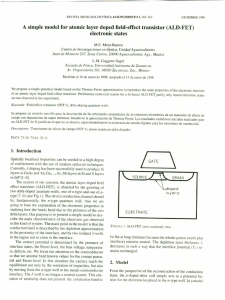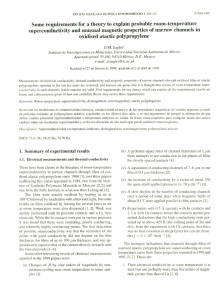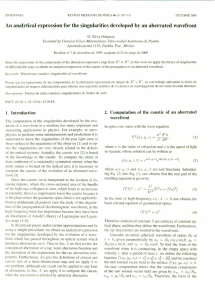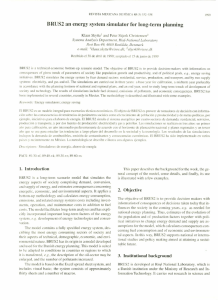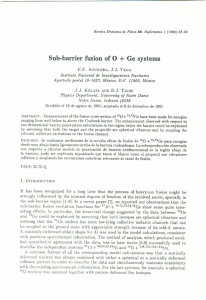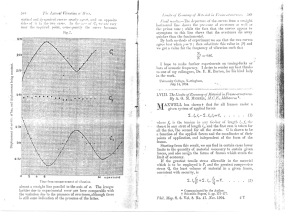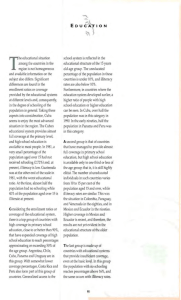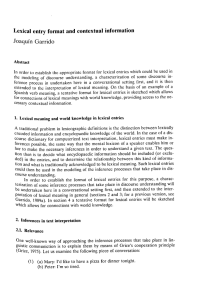Rev. Mex. Fis. S 45(2) (1999) 106.
Anuncio
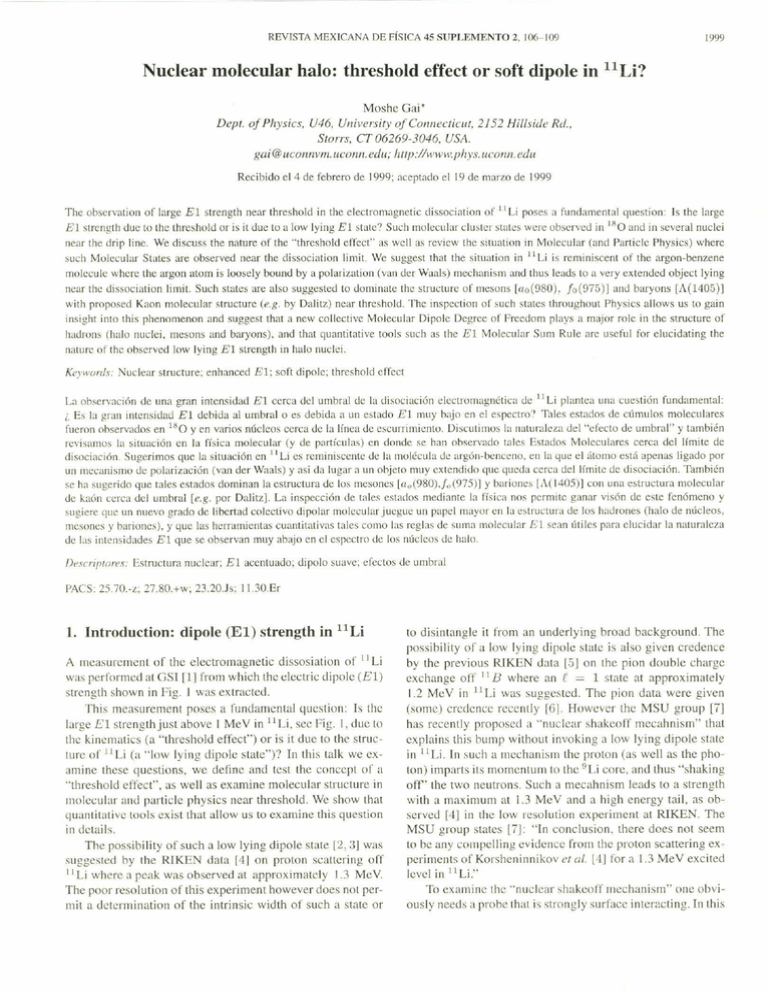
REVISTA MEXICANA DE FíSICA 45 SUPLEMENTO
2. 1()(~I09
1999
Nuclear molecular halo: threshold effect or soft dipole in
Depl.
Moshc Gai*
U46. Ulliversity nI COlltlecticllf,
2/52
Storrs. cr 06269-3046. USA.
ga i@llco1l1lvm.llc01m.edu
.. http://H'lVw.ph ys. lieOI/
(JI Physics,
HifI:úde
11 Li?
Rd ..
n. edu
Recihido el 4 de febrero de 1999; aceptado el 19 de marzo de 1999
The ohservation 01' large El strength ncar thrcshold in lhe c1cctromagnctic dissociation uf
tl
Li poses a fundamental question:
15Ihe lurge
El slfcngth tIue lo lhe thrcshold or is it due lo a low Iying El statc'! Sucll molecular cluster sIal.::!' wcrc obscrvcu in 180 and in several nuclci
I1caf Ihe drip Iinc. We discuss Ihe naturc 01' lhe "threshold effecC' as well as review lhe situntion in !\lolecular (and Parliclc Physics) where
such !\1olccular Stalcs are observed near the dissociation limiL \Ve suggcSI that the situation in II Li is reminiscent of the argon.benzene
moleculc wherc the argon alom is loosely bouml by a polarizatioll (van dcr Waals) mechanism and thus leads to a very extended object lying
near tbe dissociation IimiL Such sta[es are also suggested lo dominale Ihe structure 01' Illesons (ao(980). 10(975)] and baryons [A(140.5)J
with proposed Kaon molecular structure (e.g. by Dalilz) ncar threshold. The inspection 01'such states throughout Physics allows us to gain
insight into this phenomenon and suggest thal a ncw collective ~'tolecular Dipale Degree of Freedom plays a major role in the strueture of
hadrons (halo Iluclei, mesons and baryons). and that quantilative lools sllch as the El Molecular Sum Rule are uscful far clucidating the
nature 01'the observed low Iying El strength in halo nuclci.
KeYI\.'onls: Nuclear structure; cnhanced El; soft dipole; thrcshokl cffeet
La observnción de unn gran intensidad El cerca del umbral de la disociación electrornngnética de II Li plantea una cuestión fundamental:
¡. Es la gran intensidad El dehida al umhral o es debida a un estado El lTlUYhajo en el espectro? Tales estmlos de cúmulos moleculares
fueron ohservi.lllos en 180 y en vnrios núcleos cerca de la línea de escurrimiento. Discutimos la naturaleza del "cfc(,:to de umbral" y también
revisamos la situación en la física molecular (y Je p<:lrtículas) en dondc se han ob"cr\'ado tales Estados Molecularcs cerca del límite de
disociación. Sugerimos que la situación en II Li es reminiscente de la molécula Je arg6n-hcnceno. en la que el [¡tomo está apenas ligado por
un mecanismo de polarización (van der Waals) y asi da lugm a un ohjeto muy extendido que queda cerca del límite de disociación. También
se ha sugerido que tales estados dominan la estructura de los mcsones [au(980),j,,(975)]
y bariones IA( 14(5)] con una estructura molecular
de kaón cerca del umhral [e.g. por Dalitz}. La inspección dc talcs estados mediante la físka nos permite ganar visón de este fenómeno y
sugiere que un nuevo grado de libertad colectivo di polar molecular jueguc un papcll1layor en la estructura de los hadrones (halo de núcleos.
mesones y bariolles). y que las herramientas cuantitativas tales como las reglas de sLlma molecular E 1 sean lítiles para elucidar la naturaleza
ue las intensidaues El que se ob"ervan muy abajo en el especlro de los núcleos de halo.
/)l'scril'ton'.\': Estrueturn nuclear: El acentuado; dipolo suave; efectos de umhral
PAes: 25.70.-z; 27.80.+w; 23.20.h;
1. Introuuction:
¡UO.Er
dipole (El) strength in
11
Li
(o disintangle
possihility
A lIleasmemen(
01" the clectromagnetic
dissosiation
nI'
II
Li
was pcrformed al GSI[l] from which Ihe c1eclrlc d¡pole (El)
strenglh
sho\l,'n in Fig. I was eXlractcd.
This llleaSmemenl
poses a fundamenlal
l)lIcstion: Is (he
largc El strength just ahoye I MeV in 11 Li, see f'ig. l. tlue lo
(he kinemalics (a "threshold etlcct") 01' is it uue lo (h" struc1m" 01" II Li (a "Iow Iying uipole stale")? In (his (al k we ex-
it fmm an underlying
of a low Iying dipole
hroad
background.
The
slate is also given crcdencc
hy Ihe previous RIKEN dala [51 011[he piol1 douhle eharge
exchange off 11B whcrc an ( = 1 slale at approximately
1.2 McV in 11U was suggestcd. The pion data were givcn
(SOIllC) creJcncc recenlly [G]. Howcver lhe MSU group t7]
has reccntly proposed a '"nuclear shakeofT mecahnism"
that
The possibility of such a low Iying dipole slalc [2, 3) was
suggestcd hy Ihe RIKEN data {4J on prolon scaltcring off
llU where a peak was observed at approximately
1.3 MeV.
explains this hllmp withoul invoking a low Iying dipole slalc
in II Li. In such a lllcchanism lhe prolon (as wel! as Ihe phoIon) illlparts its ITlOmenlUIll 10 the 9Li core, and thus "shaking
off' the (wo ncutrons. Such a mecahnism
leads lo a strcngth
with a lllaximulll al 1.3 MeV and a high energy tai!. as 011servcu HJ in the low resolulion expcrirnent
al RIKEN. The
MSU group statcs [71: "In conclusion.
there Joes not seem
to be any compelling evidence rrolll (he proton scattcring expcrilllcnls of Korshcninnikov
el al. [,l) for a 1.3 MeV excited
Icvel in II Li."
Thc ¡mor resolutioll
mil a dctcnninalion
To examine the "nuclear shakeolT lllechanism"
olle obviously needs a prohc that is strongly surface intcmcling. In Ihis
Llmine Ihese questions,
we define and test the eoncept 01"a
'"threshold etIeet". as wel! as examine molecular structme in
molecular ami particle physics near thrcshold. Wc show that
quantitative tools exist that allow liS to examine this qucstion
in details.
of Ihis cxperiment howcver does not pcr01"lhe intrinsic width 01"such a state or
NUCLEAR MOLECULAR
HALO: THRESHOLD
EFFECTOR
107
SOFf D1POLE IN i1Li?
.500
Pholodi~ime£ration of Ihe deulerun
Dipole Strength
1
.~
~
••
~
"..!, 06
W
1500
Experiment
.
!«JOO
J<
b
W
¡¡¡
•
D(1. pln
tooO
"Li
500
0.2
o
Energy
80
•
234
Exclt8t1on
e. rMeV1
FIGURE t. Electromagnctic dipole (El) strength
surcd by lhe GSI collahoralion. [1}
of 11Li as rnC3-
FIGURE2. The photodisintegration ofthe deuteron.
d(y,n)p
case lhe mOlllcnlUm could not he sole1y transfcrrcd lo Ihe 9U
core and ncccssarily involvcs the "halo" ncutrons al the SUffaec. Such a probc is Lhepian (as wcll as othcr probes) and wc
conclude Ihal the double pian scattering data of thc RIKEN
group 151 pose sume difflculty to lhe "nuclear shakcoff Illcchanism"
2. Threshold effect: photodisintegration
deutron and BU
0••.",75 yb'c
=
.,
:¡;
" ,~
o
of the
.
,
E~ (MeV)
Thc photodisintcgration 01' lhe deutron shown in Fig. 2, provides a vivid example 01'a "thrcshold cffcel".
Namcly,
lhe peak
shown
in Fig.
=
(2,1, + 1)(2,1, + 1) k'
(
------- a 11
2(2.f:¡+ 1)
k:(
)
,
2
vclocity (v):
a(lI, 1)
=
(aE1/')0
=
(a,,)o [~+ü+1v+
,
(
¡le a 11,1
[E-1/'
+
ü
+ 1E'/2
... ],
+ ... ]
(2)
lJ
(2,1, + 1)(2,1, + 1)
,E
(
)
211c 2 a n,1
2( 2.f:¡+ 1)
Eo
(2,1,+1)(2,1,+1)2
2(2,13+ 1)
FIGURE3. The photodisintegration of the deuteron as describcd by
thc sccond lerm (n) of Eq. (2).
2 al approximatcly
4.4 MeY does not corrcsponds to a state in the proton-neutron
systcm ano arise from the kinematics as we discuss below.
The photo nuclear cross section is derived using standard
Ilotatioll from dctailed halance:
ah,n)
.
)Eo-Q
E:(
,
(1)
where the factor of 2 in the denominator arises from the
two polarization sIates 01' a real transverse pholon and
q = 2.223 MeV, is the one neutron scparation cncrgy in
deulerium. The kinemalical factor (Ro - Q)/ E:; produces a
peak at 20 in the ah. n) cross scction cven in the ahscnce
01' a peak (e.,g. a stalc) in the a(n, ,) cross section. Anu wc
conclude that Ihe peak al 4.4 MeV (= 2(J) in Ihe photodisintegralion 01' the dcutron is solely due to that kincmatical
fJctm and we define it as a "lhreshold cffect". But wc note
{hat in the electromagnctic dissociation of 11 Li one ohserves
a pcak al approximately 1.2 MeV, see Fig. 1, which is four
times the two neutron scparation in II Li (Q = 300 kcV), and
!lencc t!lis peak in 11 Li can not arise from thc ahoye kincmatical ",etor [ofEq. (1)] alone.
The capture of slow neutrons hy nuclci is wcll under
stood rS-ll] and can he expanded in teTms of the neutron
w
and for thermal ncutrons V(J = 2200 mIs ((Jo = 7.3 X
10-';) and ao = 333 I11h for the I'(n, -¡)d rcaelion, thus
("v)o = 2.5 lIbe. for spin zcro particles [9] we have
(1
= (III(¡,¡")(A/(A + 1)'. The intcraetion of slow neutrons (up to a fcw hundrcd keV) is dominated by 8-waves
with a large wave length. and is therefore dependcnt mainly
nn the timc spent neaT thc targct giving risc to the well known
llv dependencc 01' lhe cross scction. At higher energics, pwaves dominatc and Ihe o' tefms is most important, and indeed the photodisintcgration of the deuteron is given by that
term (for o. 0.8) as shown in Fig. 3. In the same figure we
also shl1w the (p-wave) conlinuum El ealculaled by 8ethe
and Longmire [12] (which clearly does nol arise from an El
dipole state al 4.4 MeV in the deuteron). We conclude Ihal
the peak al 2q = 4.4 MeV in Ihe phOlodisinlegration 01' Ihe
dcutron is a manifestation 01' a "threshold effect".
Thc phntodisinlcgration 01' BLi represents yet anothcT
good example al' a threshold effect. In Fig. 4 wc show
these data as dcduccd from the direct capture of neutrons on
7Li (13]. The interaclion of the low encrgy neutrons is indeed dominatcd hy s-wavcs [13] and the cross section of the
'Li(n, 1)'Li follwos Ihe l/v law, as shown in Fig. 4. The pho-
=
Rel'. Mi'x. FÍs. 45 S2 (1999) 106-109
108
MOSIlEGAI
8
.,'
"'.>"'"
FIGURE 6. Charactcristics dimensions of lhe Ar-benzen molecule,
<ldopted fmm Iilchcllo ,md Lcvinc [l4J
o
E y(Me\')
FIGURE 4. Thc pothodisintegration
ofthc 8Li. derivcd fmm dircct
capture data [1:31.as dcscribed by {he fJrst !cnn of Eq. (2)-lhc 1/1'
l;lW.
0••• .\ IIh.",1 +
"".1
!IU(y.2n)
two neulrons with two Jifl"crcnt velocitics, lhe low vclocity
neulron lenJs lo push (he shape lo lower energies, considerahly helow 4(2 = 1.2 MeY, as discussed ahove.
4. Molecular sta tes in molecular and particle
physics
l'U
;....
400
':"2
5200
The uhquitous occureence 01" molecular slates !lear thre.shold
in Physics may indecd allow for insight into lhe slructure of
¡lLi amI other such "halo" 1llH:lci. In Pig. 6 we show char-
¡11It1rJ¡ .,
300
'"
..~
00
05
10
15
2.0
2.5
3.0
Ey (l\fcV)
FIGURE S. Elcctromugnclic
dipolc (El) slrength 01'
11
Li and al-
tcmps lo describe it by Icrms 01' Eq. (2).
cross scction is given hy lhe f¡rst lerm of Eq.
7.3 x lO-o x 40
0.29¡1bc. NOle Ihe
01"(an intcrfcring) 3+ statc on lOr 01' el thrcshold
todisintcgration
(2), wilh (""),,
ohscrvation
cffecl.
=
=
3. The photodisintegration
Thc photodisintcgration
aclerislic dilllensions of the Ar-benzen molecule. The argon
;¡(om is losely hound to the (tightly hound) henzen molecule
by a van del' Waalls polarization and lhus this molecular state
lies closc to the dissocialion
¡imil. \Ve note lhal the relative
dimension and inJeed the very polarizalion
phenomena
are
reminscenl 01" Ihe structure of 11 Li where the argon atom creates a "halo" al"Ound Ihe benzen molccule.
Indced the slructure of haryons and mesons near Ihrcshold was suggcsled 10 he governet.l by a molecular degrce of
rreedom. The ,\(1.105) Ihallies elose lo Ihe N+Khar Ihresh-
01" (1435 McY) was proposed
[15]10 hc 'In 8-wave
Ihe scalar meson (/0(980)
hy Dalill
NKhar moleeule.
Ami similarly
and Ihe fo{9S0) meso n that lie near Ihe KKhar lhreshold at
1)95.4 MeV, were proposcd by Weinslein and Isgur [16) to
01'11 Li
01' 11 Li helow 1.0 McV yiclds
(Wo
low cnerg:y neutrons with vclocities that Illay diffcf. But lhe
1\\'0 ncu(rons are in t~lCtohserved lo emerge with almosl idclltical cncrgics (see Fig. 10 of [1}), as onc may expect for halo
ncutrons. Hence we makc Ihc assumption
that lhe two IlClllrons are cmilled wiLh thc samc velocity (but not implying
a physical Ji-nculron
objcct) and we use this vclocity in the
paramaterizalion
of Eg. (2). For these low cncrgy neutrons
(approx. 300 keY [1]) we also expecI Ihe l/v law, as discussed abovc. In conlrast the GSI dala cannat be deseribeu
by lhe l/u law, or any of the terms 01' Eq. (2), as shown in
Fig. 5. In panicular Ihe thirJ term in Eq. (2) (ror 'Y
O.G)
docs not yield a peak at 1.2 MeV. However Ihe shapc 01' the
spcclrum is sufflcicntly uncertain that we can not rule out a
'.Ihrcshold cITec!" and Ihis analysis tilus ealls for mOfC accuralc dala on Ihc shapc of Ihc spcctrum, su as 10 Icst Ihe validity
of "Ihrcshold clfcet". Note that ror a single stcp caplure 01'
=
have the slrllcturc 01"a KKhar molccule, anJ a signalure ror
slIch a molecular stllclure \\'as sllggesled (171 to he given by
lhe ratio 01"the branching ra(ios of lhe radiativc decay 01"Ihe
<p llleson to Ihe no anJ lhe Jo mesons.
5. The lIlolccular degree 01'freedom and molecular sum rules
A molecular dcgree of frcedotll is characlerized
by excita~
lions that involves Ihe relalivc Illolion 01"two tightly bounJ
objects and not the excitatioll orthe ohjects lhemsclve. Hence
it is associated with a polarizalion
veclor known as the separation vector. Such a vector can be descrihcd geomclrically
in three Jimellsions 01' hy using the group U(4) [18] and lhe
very sllcccsrul Vihron lIlodel 01"lIlolccular Physics [141. This
model has Iwo symmctry limits tha( corresponds
lo Ihc gcoIllctrical descriptiol1 01"rigid 1Il0lecules. lhe 0(4) limil, or son
Illolecules, (he U(3) limi!.
Rel'. Me.\". Fú. 45S2(1999)
106-109
NUCL~AR
MOLECULAR
HALO: THRESHOLD
The polarization phcnomena associaled wilh a molecular
slale implies lhal il should he associaled wilh dipole excitations 01' the separation vector. In this case expectation values
01" Ihe dipole opcralor do nol vanish as the center 01' mass and
ccntcr of chargc of the polarized molecular state do nol coincide. Hcnce Illolecular states give rise to low Iying dipole cxcilations. While rhe high Iying Giant Dipolc Resonacc (GDR)
is a.ssociated \Vith (a Goldhaher- Teller) excitation 01 the neutron distrihution against that of lhe prolon, a molecular excit<llion involves a smaller fraction 01' lhe nuclcons at the surrace and is Ihus expected lo occur at lowcr excilation; ¡.e. a
soft dipolc mode.
The GDR excilalion exhausls the (TRK) encrgy weighted
dipole sum rule:
= Ei 3(EI
S¡(EI:.4)
: 0+ --+ li) x £'(li)
9 NZ e'f,2
47f
A
(3 )
2m
Alld 1m a molecular state Alhassid, Gai, and Bertseh [191 derived sum rules hy sublracling the individual sum rules 01" lhe
conlituents fmm the total sum rule:
EFFECT OR SOFr DIPOLE IN
11
109
Li'!
clear molecule ('Li+11 + '11). Ano the sum rule (as a kincmatical Illooel) does not allow us to dislinguish helween Ihe
two molecular cases. Thcse molecular sum rules (Eqs. 4 and
5) were shown 10 he useful in elucidaling molecular (cluster) states in 1'0 \Vhere Ihe measurerl 3(EI)'5 and 3(E2)'5
cxhaust 13LJo and 23%, respcc.:lively, 01' the molecular sum
rule [20). Similarily, Ihcsc molecular stalcs in IHO have alpha widths that cxhausl 20% of the Wigncr sum rule. Thc
hranching ralios fUI"clcctromagnclic decays in 180 wcre also
shown lo he consistent wirh predictions 01' the Vibron model
in the U(3) limit 121]. Indeed the manilestation 01 a molecular
slruclurc in ¡HO has altercd our undertsanding 01' Ihe cocxistence 01' dcgrecs 01' freedoms in 180 [22].
The dipolc sLrcnglh al approximately 1.2 MeV in llLi.
shown in Fig. 1, cxhausls 20% of the two neulrons molecular slIm rule, and lhe IOlal strength inlegrated up lo 5 McV
exhausts 100% oí"lhal SUIllrule. We emphasize Ihat the experimental cftkiency al for cxample 6.0 MeV is very large
(30%) ll], hut no strcnglh is founJ al higher energics heyond
100% 01' the molecular sum rule. These lwo facIs strongly
suggcsl the cxistence 01' a low Iying 50ft dipolc moJe in 11 Li.
6. Conciusion
(4)
(5)
Note that Ihe sum rule for two neutrons molecular slales,
Sj (:2/1 + A2), is the same whether one assumes a "di-atomic"
nuclear Illolccule (HLi+ a dineulron), or a "tri-atomic" nu-
InviteJ talk. XXII Symposium on Nuclear Physics, Jan. 6-9.
1999. Onxtcpec. J\.1éxico.
1. M. Zinser
l'(
al.. Nl/cI. Php. A619 (1997) 151.
2. K. Ikeda N"cI. Phys. A538 (1992) 355c.
.3. P.G. Hansen. Nuel. Phys. A588 (1995) le; P.G. Hansen <lndA.S.
Jcnsen. AIlIlIl. Rel'. Nuel. Parto Sci. 45 (1995) 591.
4. A.A. Korshcninnikov elal., Ph)'s. Re\'.Ll'!l. 78 (1997) 2317.
In conclusiol1s we demonstralc that quanlitative tools exist
to test the validity 01 the "threshold eITeet" and the "soft
dipolc molle" inlcrpretalion 01' lhe dipole (El) strcngth in
11 Li. More precise dala are nccdcd to rule oul one or the other
inlerprctation alld this papel' may serve as an impetus for such
data. Currenl intcrpralion is consistenl wilh Ihe cxistence of
a low lying dipolc mode in lL Li al approximatcly 1.2 MeV.
iJl1llmay pose diffkultics lo othcr intcrprctations.
Acknowledgments
Work
supported
hy
USDOE
Grant
No.
DE-rG02-
94ER40X70.
12. II.A. Bctlle ami C. Longmirc. Phy.\'. Rev. 77 (1950) 647.
13. M. Heil. F. Karpler. M. Wiescher, A. Mengoni. A. Phys.
507 (1998) 997, ano references thcrein.
14. F. lachcllo and R.D. Lcvinc. Algebmic Theory
(Oxford University Press. New York, 1995) .
DI
101/r.
MoleclIles.
1!J. R.H.
Dalitz, LoH' amI Illlermnliatl'
Ellergy Kaoll-Nude//.\"
Physics, (Oxford University Press, Oxford, 1981) p. 381.
j.
T. Kobaynshi. Phys. Ll'll. A 53S (1992) 343c.
IG. J. Weinstein amI N. Isgur. Phys.
(j.
~1.G. Gornov el al., Phys. Rel'. Letl. SI (1998) 4325.
l.
S. Karalaglidis ('/ al., P/¡ys. Re\'. Lell. '79 (1997) 1447.
17. F. Close. N. Isgur. and 5. Kumano. Nuc/. Phys. B389 (1993)
513.
8. J.1\1. Blatt anu VE Wcisskopf.
(Wiley. Ne\V York. 1952).
o
T/¡eort,/iml Nue/ear Physics.
18. F. lachello and A.D. Jacksoll. Plty.\'. Lelt. IOSB (l9K2) 151.
(1982) 1482.
lO. A.A. Bcrgmnn and EL. Shapiro. Sov.
(1')6\)
JOIlr.
Phys. JET?
U
20. t\l Gai ('(.a/.. Phys. Re\'. Lefl. 50 (19X3) 239.
21. M. Gai el a/.. J'hy.\'. R('\,.
895.
t>l a/.. SOl'.
Jow:
Len. 4H (1982) 659.
19. Y. Alhassid. M. Gai. and G.F. Bcrtsch. },h.vs. Rev.
EL. Shapiro. JETP 7 (1058) 1132.
11. 5.B. Borazkov
Rl'V.
Nlle/.
Phys. 35 (1982) J07.
Rel'. Me.\".
e 43
(1991) 2127.
22. M. Gai el al.. f'hy.\'. RCl'. Lell. 62 (1989) X74.
FI\. 45 S2 (1999) 1Oú-I 09
un
49
